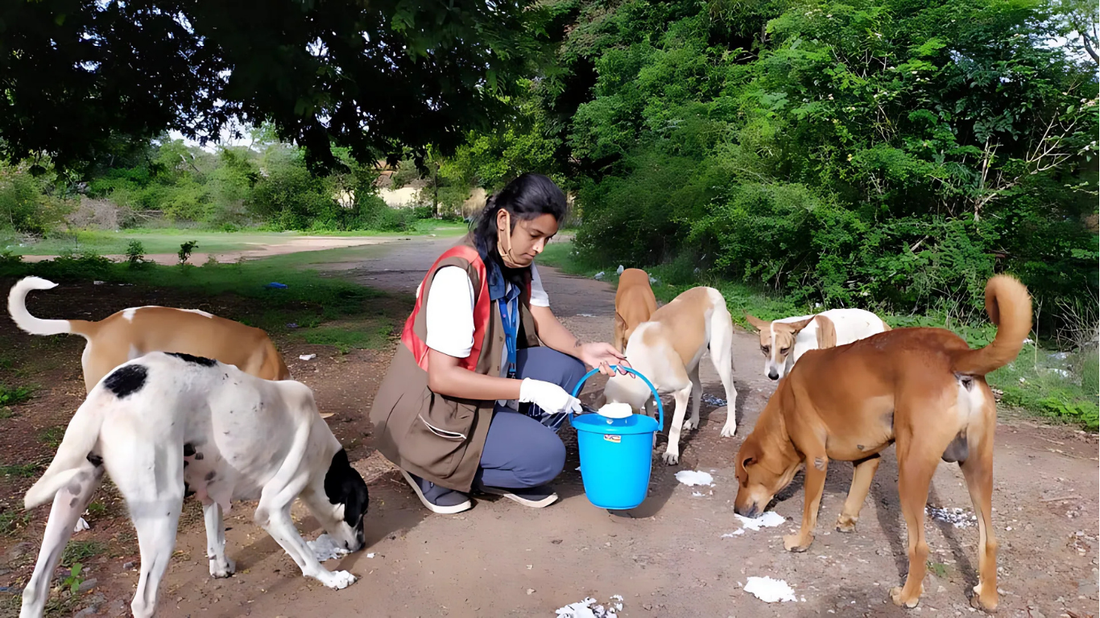
No Feeding in Public Places: Supreme Court’s Stand on Stray Dog Management
Share
Stray dogs have always been a sensitive subject in India. They are loved by many, fed by kind-hearted citizens, yet feared by others because of rising bite cases and safety concerns. With over 1.5 crore stray dogs across the country, managing them has become both an animal welfare issue and a public safety challenge. Recently, the Supreme Court of India stepped in with clear directions on how stray dog management should be carried out — focusing on sterilization, release, and regulated feeding practices.
This ruling is expected to change the way communities, local authorities, and animal lovers interact with street dogs. Let’s break it down.
The Supreme Court’s Key Observations
The Supreme Court emphasized that:
- Sterilization and Vaccination is Mandatory – Stray dogs should not be randomly relocated or culled. Instead, they must be captured, sterilized, vaccinated against rabies, and released back to the same area.
- No Feeding in Public Spaces – The Court has barred individuals from feeding stray dogs in public places such as streets, markets, or residential colonies. Feeding should only happen in designated zones decided by municipal bodies.
- Balancing Animal Welfare and Human Safety – The Court clarified that the intent is not to deprive stray dogs of food, but to prevent clashes between residents and feeders, and reduce health risks in crowded areas.
Why Sterilization Matters

Stray dog populations grow rapidly if unchecked. One female dog can give birth to multiple litters in a year, creating a cycle of uncontrolled breeding. Without proper management, this leads to:
- Higher numbers of strays in urban spaces
- Increased chances of dog bites
- Greater spread of rabies and other infections
By making sterilization mandatory, the Supreme Court aims to control the population in a humane way. Countries like Sri Lanka and Nepal have already shown success with this approach.
Why Public Feeding is Being Curbed
For many animal lovers, feeding stray dogs is an act of compassion. However, the Court observed that unregulated feeding in public places often leads to:

- Aggressive Behavior: Dogs become territorial around feeding spots and may attack passersby.
- Community Conflicts: Residents who fear dogs often clash with feeders.
- Hygiene Concerns: Leftover food attracts flies, rodents, and creates waste in public spaces.
By shifting feeding to designated areas, the aim is to protect both the dogs and the public while maintaining urban hygiene.
What This Means for Animal Lovers
The Supreme Court has not stopped people from caring for stray dogs. Instead, it encourages a more structured and safe approach:
Feed dogs only in designated feeding zones decided by municipal authorities.
Avoid feeding in crowded streets, schools, markets, or residential building entrances.
Support sterilization drives by NGOs and local animal welfare groups.
This way, compassion can go hand-in-hand with responsibility.
The Larger Debate: Stray Dogs vs Public Safety
The ruling comes in response to rising concerns across cities like Kerala, Delhi, Bengaluru, and Mumbai, where stray dog attacks have made headlines. Parents worry about children’s safety, while joggers, cyclists, and delivery workers often face sudden chases or bites.
On the other hand, animal welfare activists argue that stray dogs are part of the ecosystem, providing protection against theft, and that aggression often stems from mistreatment or starvation.
The Court’s decision tries to balance both perspectives — protect dogs through sterilization and feeding, but also safeguard citizens from uncontrolled stray behavior.
Responsibilities of Municipal Authorities
The Supreme Court has placed a strong duty on local authorities to:
- Run sterilization and vaccination programs consistently.
- Identify and notify designated feeding spots.
- Work with animal welfare organizations to monitor dog populations.
This means cities and towns can no longer ignore the issue or leave it entirely to NGOs and volunteers.
What Pet Parents and Citizens Can Do
If you are a pet parent or animal lover, here are a few ways to align with the new guidelines:
- Volunteer in Sterilization Drives – Help NGOs with transportation, awareness, or funding.
- Feed Responsibly – Stick to designated zones; carry food and water bowls that don’t litter the streets.
- Raise Awareness – Educate neighbours that sterilized and vaccinated dogs are less aggressive and safer for the community.
- Adopt, Don’t Shop – Encourage adoption of strays to give them permanent homes.
Why This Step Could Be a Turning Point
India’s stray dog problem is not new. But this is the first time the highest court of the country has laid down clear, uniform rules. If followed sincerely, this could lead to:
- A decline in stray dog population within a few years
- Reduced rabies cases and bite incidents
- More peaceful coexistence between humans and animals
Ultimately, the judgment is about creating a society where compassion meets responsibility.
Conclusion
The Supreme Court’s ruling on sterilization and regulated feeding is a landmark step in addressing one of India’s long-standing urban challenges. It acknowledges the rights of stray dogs while also protecting public health and safety.
The message is clear: we can love and care for stray dogs, but it must be done responsibly. Compassion should never come at the cost of safety, and safety should never come at the cost of cruelty. With the right balance, India can set an example for humane stray dog management worldwide.
